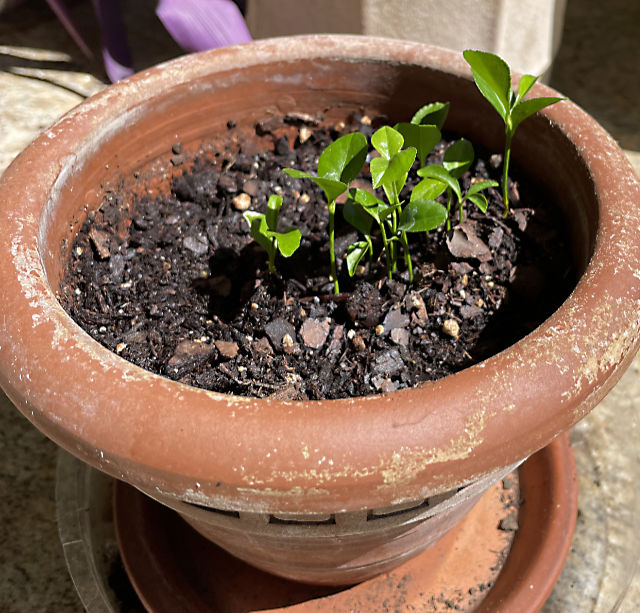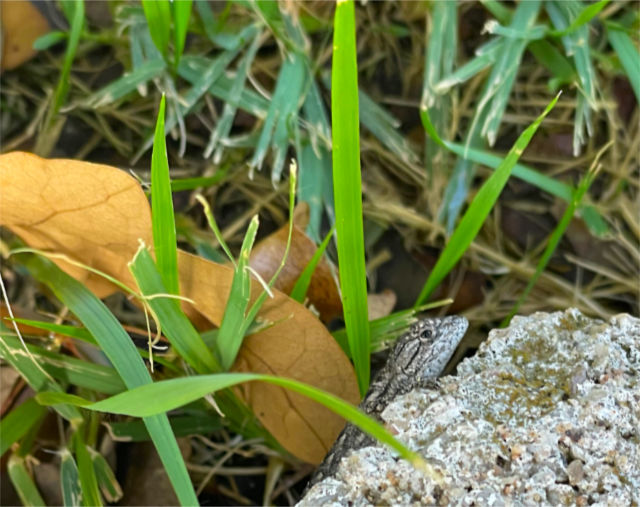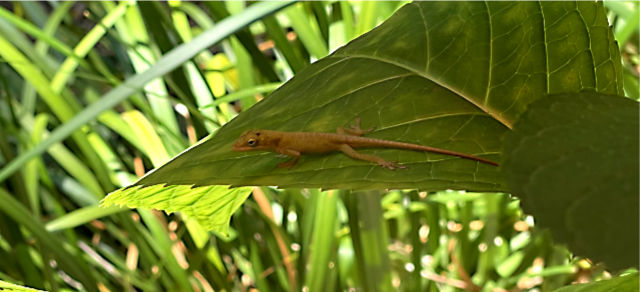It occurred to me this afternoon that the effects of our seemingly endless days of triple digit temperatures are not that different than what we endured during the GPS (Great Pandemic Shutdowns). While we’re not now forced to stay at home, it’s too miserable outside to be anywhere else, so we knock around the house, rearranging bookshelves, contemplating housecleaning but not having the energy to actually do it, and…well…trying to summon the motivation to do some blogging. I’ve already done the first two things today, so I might as well give the third one a go.

The photo at the top of this page documents a common sight: squirrels splooting on our back porch. We’ve seen up to three at a time splayed out on the concrete, trying to beat the heat.
The critters in the photo are Eastern fox squirrels, aka tree squirrels; we also have a population of rock squirrels in our neighborhood (I’ve written about them previously). Rock squirrels are larger than their tree-dwelling cousins, and more skittish and much less common, at least around our house. It’s rare that they’ll come near our house, but the heat may be making them bolder, or at least more desperate.

Above: This rock squirrel is munching on a sweet potato vine on our front porch.
Below: It also took some time to display its splooting skills.


I don’t know if amphibians are bothered by the heat; it’s hard to read their expressions. Take this Gulf Coast toad for example, resting on the tree ring around the pecan tree on our back deck:

Is it dismayed by the heat, or is it just naturally grumpy? It’s a question that I’m qualified to ask, but not qualified to answer. In any event, it’s been hanging around for a couple of days.
Debbie also discovered a distant relative to Mr. Toad hiding among some purple queen sprigs that she’s trying to root. As best I can tell, it’s a tiny tree frog, and it seems quite content to lounge in the manmade marsh.

Above: This mass of purple queen sprigs has a tiny squatter.
Below: Can you make it out?


Speaking of attempts to cultivate plants, Debbie’s lime tree orchard — which I introduced here about a month or so ago — is developing remarkably well. Almost ten of the seeds she planted have germinated, and so far the seedlings have not been molested by squirrels, caterpillars, or birds.


Let’s move on to the world of insects. This walkingstick was hanging out in front of our garage a couple of weeks ago.

This one was about 6″ long, from antennae to tail, but some species native to Asia grow to two feet in length. I also never realized that some species can fly, albeit not very far or very gracefully. And, finally, while I’ve always considered them to be docile and harmless, the reality is a bit different, depending on the species…as in, they can actually hurt you or your pets. (Pretty sure those around these parts don’t fall into that category. Kinda sure. Ah, who knows?)
Here’s a beautiful specimen of moth:

This is a vine sphinx moth (Eumorpha vitis), somewhat common in the southern part of the US. The larvae feed on grapevines, primrose, and a species of magnolia tree. I haven’t found any reports where they’ve caused significant damage to any of the myriad of vineyards in the Texas Hill Country, but here’s an article documenting the danger to vineyards of other species of sphinx moths. It’s worth noting that the hated tomato hornworm is the larval form of yet another species of sphinx moth…the fascinating hummingbird moth.
By the way, the moth pictured above was a willing subject due primarily to the fact that it was, well, dead.

Speaking of demise, we had a near-death occurrence last week when this beautiful bird had a hard collision with one of our windows.

This is a female painted bunting, and we did fear for its life after the impact. It appeared unable (or unwilling to fly) and we worried that either a predator or the heat would end it, assuming it could recover from the hit. We were able to move it to shaded and protective shelter, and it took two days to recover enough to finally fly away.
These birds are not exactly rare in this part of the state, but neither are they everyday sightings, at least not in our yard. And it’s hard to believe that the coloring of the female is also the same as that of the juvenile male, considering the brilliance of the adult male’s plumage.

We’ll wrap things up with a few reptile reports. First up…this encounter with the smallest Texas spiny lizard I’ve ever seen:

I realize that it’s impossible to get a sense of scale from this photo, but it was no more than 2″ long, and very shy. I was fortunate to get this picture before it disappeared into the grass. Assuming it survives, it will grow to 8-10″ in length.
The lizard in the next photo puzzled me. I knew it was an anole, but which species? I’m most familiar with the green anoles (Anolis carolinensis) that flourish around our house, and they are a native species. But there’s another non-native/invasive species in the US called, imaginatively enough, the brown anole (Anolis sagrei). This species multiplies rapidly and will quickly take over the anole ecosystem. But I’m not experienced enough to be able to easily distinguish between the two species. Green anoles can change their color to brown, but brown anoles cannot become green…they just get darker brown or black. So when I see a brown-colored anole like this one, I can’t help wondering…

Is it…or is it not?

Fortunately, although the brown anole is now appearing in parts of Texas, I can’t find any online evidence that they’ve moved en masse into the Texas Hill Country, although there’s one report in iNaturalist of a sighting in Marble Falls, just up the road from where we are. That sighting was made in 2017, and was flagged as an organism of “anthropogenic origin,” meaning that it was introduced via human activity. There’s no evidence that a breeding population exists.
All of that is to say that the lizard in the photo is a green anole, and the reason for its brown coloration is a mystery to me. By the way, it’s interesting (to me, anyway) that the green anole is considered to be an invasive species in Japan, where it’s been found to be a carrier of Salmonella.
But, while we’re on the subject of anoles, here’s one reason why I like them:

Debbie spotted this one on a rock column on our back porch. If you look closely, you can see that it has a spider in its mouth. Anoles prey on arthropods like spiders, and while spiders also play an important role in our ecology, I’m all in favor of them acting as sustenance for our lizard population.
That pretty much catches us up on what’s going on in the wacky world of nature in our neighborhood, so until next time…
…oh, wait, there’s one more bit of important scientific flotsam that I’m sure you need to consider…

Discover more from The Fire Ant Gazette
Subscribe to get the latest posts sent to your email.


Nice roundup of the local fauna, and the photos are very nice. Now, I must go sploot.
Well, you know what they say…when ya gotta sploot, ya gotta sploot.
Eric,
I can’t remember (actually I can’t remember a lot of things) if I have shared how much I enjoy the Fire Ant Gazette. You do a very nice job!
Why, thank you, Sonnie! Uh, do I owe you money? 🤣